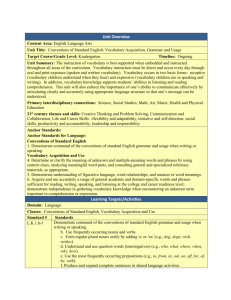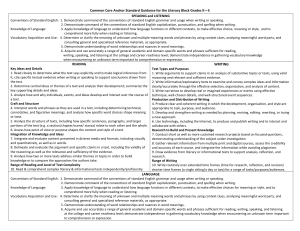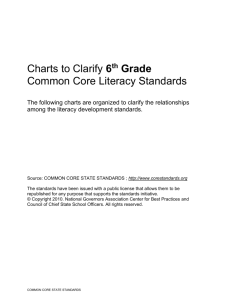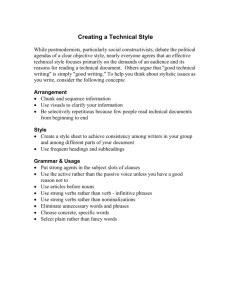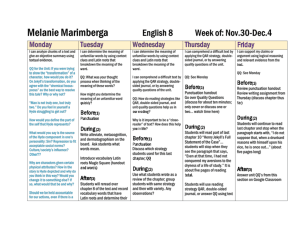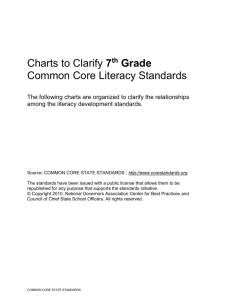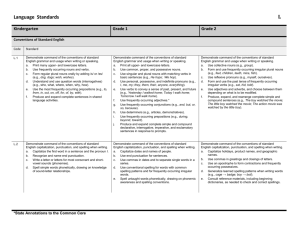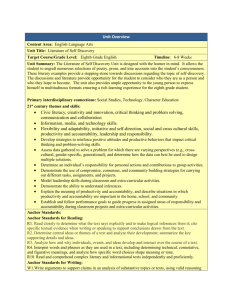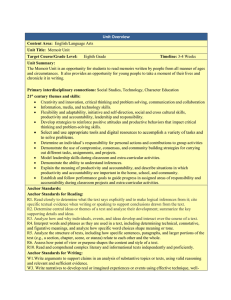Language & Literacy Foundations / Standards Comparison 3
advertisement
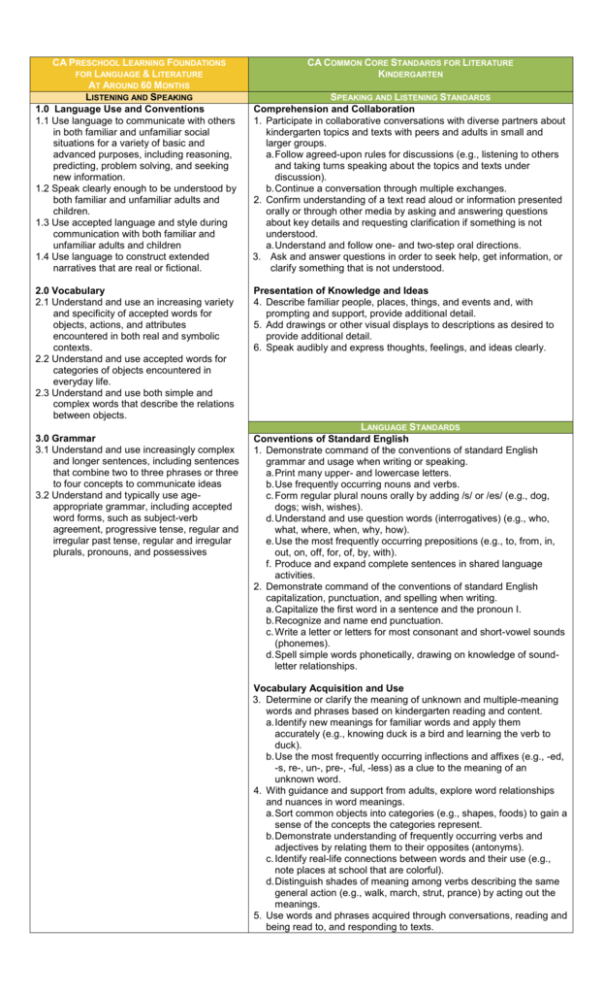
CA PRESCHOOL LEARNING FOUNDATIONS FOR LANGUAGE & LITERATURE AT AROUND 60 MONTHS LISTENING AND SPEAKING 1.0 Language Use and Conventions 1.1 Use language to communicate with others in both familiar and unfamiliar social situations for a variety of basic and advanced purposes, including reasoning, predicting, problem solving, and seeking new information. 1.2 Speak clearly enough to be understood by both familiar and unfamiliar adults and children. 1.3 Use accepted language and style during communication with both familiar and unfamiliar adults and children 1.4 Use language to construct extended narratives that are real or fictional. 2.0 Vocabulary 2.1 Understand and use an increasing variety and specificity of accepted words for objects, actions, and attributes encountered in both real and symbolic contexts. 2.2 Understand and use accepted words for categories of objects encountered in everyday life. 2.3 Understand and use both simple and complex words that describe the relations between objects. 3.0 Grammar 3.1 Understand and use increasingly complex and longer sentences, including sentences that combine two to three phrases or three to four concepts to communicate ideas 3.2 Understand and typically use ageappropriate grammar, including accepted word forms, such as subject-verb agreement, progressive tense, regular and irregular past tense, regular and irregular plurals, pronouns, and possessives CA COMMON CORE STANDARDS FOR LITERATURE KINDERGARTEN SPEAKING AND LISTENING STANDARDS Comprehension and Collaboration 1. Participate in collaborative conversations with diverse partners about kindergarten topics and texts with peers and adults in small and larger groups. a. Follow agreed-upon rules for discussions (e.g., listening to others and taking turns speaking about the topics and texts under discussion). b. Continue a conversation through multiple exchanges. 2. Confirm understanding of a text read aloud or information presented orally or through other media by asking and answering questions about key details and requesting clarification if something is not understood. a. Understand and follow one- and two-step oral directions. 3. Ask and answer questions in order to seek help, get information, or clarify something that is not understood. Presentation of Knowledge and Ideas 4. Describe familiar people, places, things, and events and, with prompting and support, provide additional detail. 5. Add drawings or other visual displays to descriptions as desired to provide additional detail. 6. Speak audibly and express thoughts, feelings, and ideas clearly. LANGUAGE STANDARDS Conventions of Standard English 1. Demonstrate command of the conventions of standard English grammar and usage when writing or speaking. a. Print many upper- and lowercase letters. b. Use frequently occurring nouns and verbs. c. Form regular plural nouns orally by adding /s/ or /es/ (e.g., dog, dogs; wish, wishes). d. Understand and use question words (interrogatives) (e.g., who, what, where, when, why, how). e. Use the most frequently occurring prepositions (e.g., to, from, in, out, on, off, for, of, by, with). f. Produce and expand complete sentences in shared language activities. 2. Demonstrate command of the conventions of standard English capitalization, punctuation, and spelling when writing. a. Capitalize the first word in a sentence and the pronoun I. b. Recognize and name end punctuation. c. Write a letter or letters for most consonant and short-vowel sounds (phonemes). d. Spell simple words phonetically, drawing on knowledge of soundletter relationships. Vocabulary Acquisition and Use 3. Determine or clarify the meaning of unknown and multiple-meaning words and phrases based on kindergarten reading and content. a. Identify new meanings for familiar words and apply them accurately (e.g., knowing duck is a bird and learning the verb to duck). b. Use the most frequently occurring inflections and affixes (e.g., -ed, -s, re-, un-, pre-, -ful, -less) as a clue to the meaning of an unknown word. 4. With guidance and support from adults, explore word relationships and nuances in word meanings. a. Sort common objects into categories (e.g., shapes, foods) to gain a sense of the concepts the categories represent. b. Demonstrate understanding of frequently occurring verbs and adjectives by relating them to their opposites (antonyms). c. Identify real-life connections between words and their use (e.g., note places at school that are colorful). d. Distinguish shades of meaning among verbs describing the same general action (e.g., walk, march, strut, prance) by acting out the meanings. 5. Use words and phrases acquired through conversations, reading and being read to, and responding to texts.


